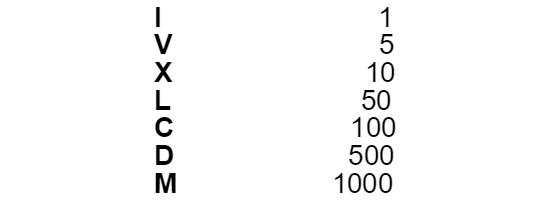Roman numbers or Roman numerals are numerical representations that were invented during the ancient Roman Empire.
The Romans, to facilitate their numbering system, instituted a pattern of letters based on the Latin alphabet as representatives of certain numerical importance.
Roman numbers are represented by the following capital letters: I, V, X, L, C, D, M, where:

The ancient Romans did not know the number zero, so there is no representation for zero in Roman numerals.
Table of Roman Numbers (1 to 3,000)
I - 1
II - 2
III - 3
IV - 4
V - 5
VI - 6
VII - 7
VIII - 8
IX - 9
X - 10
XI - 11
XII - 12
XIII - 13
XIV - 14
XV - 15
XVI - 16
XVII - 17
XVIII - 18
XIX - 19
XX - 20
XXX - 30
XL - 40
L - 50
LX - 60
LXX - 70
LXXX - 80
XC - 90
C - 100
CC - 200
CCC - 300
CD - 400
D - 500
DC - 600
DCC - 700
DCCC - 800
CM - 900
M - 1000
MM - 2000
MMM - 3000
Rules for using Roman Numbers
There are some rules for using Roman numerals, such as:
- The letter I is used only before the V and the X, for example: IV = 4; IX = 9.
- The letter X is used only before L and C, for example: XL = 40; XC = 90
- The letter C is used only before the D and the M, for example, CD = 400; CM = 900
- The letters I, X, C and M are only grouped followed three times, for example: III = 3; XXX = 30.
- To represent numbers greater than 4000 use a dash above the letters, which means multiplying the number by one thousand.
- Equal letters add up the values, for example: II = 2; XX = 20.
- Two different letters with the smallest before the largest subtract their values, for example: IV = 4; IX = 9.
- Two different letters with the largest before the smallest, add up their values, for example: VI = 6; XI = 11.
- If between any two letters there is another smaller one, its value will belong to the letter following it, for example: XIX = 19; LIV = 54.
See also the meanings of Numbers and learn more about the Arabic numerals.
